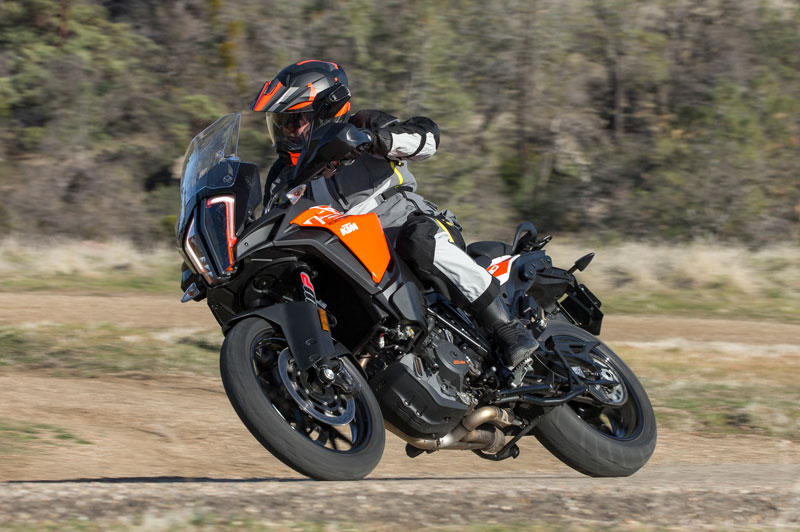
With aggressive, chiseled design by Kiska and modular architecture, KTM’s range of liter-class motorcycles share common elements (engine, trellis frame, instrumentation) but are tailored to individual missions. The beating heart of the lineup is the liquid-cooled, 75-degree LC8 V-twin that’s been bulked up and sharpened over the past 15 years, from the original 942cc, 98-horsepower, carbureted version that powered the 2003 950 Adventure to the 1,301cc, 177-horsepower, fuel-injected version in the latest 1290 Super Duke R. True to KTM’s “ready to race” philosophy, the LC8 has proven itself time and again, from winning the Dakar Rally in 2002 to smashing the two-wheel record in the Pikes Peak International Hill Climb in 2017.
Read our 2017 KTM 1090 Adventure R vs. Honda Africa Twin showdown here!
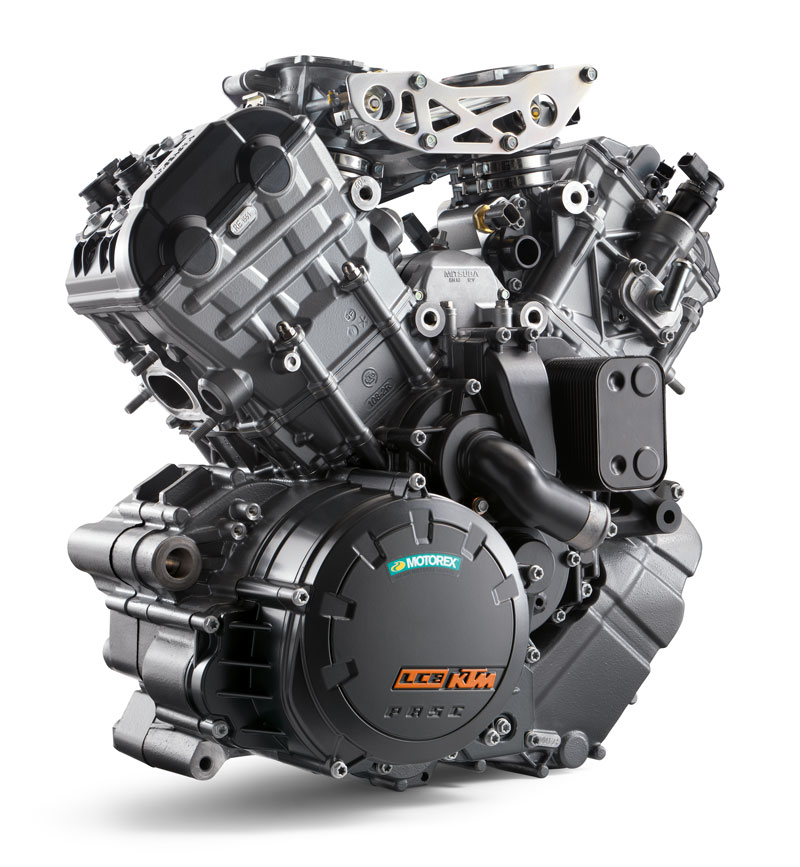
We’ve tested—and been impressed by—nearly all LC8-powered models over the years, but KTM made a quantum leap forward in 2014. That’s the year it shifted from the raw-and-rowdy era of the 950/990 Adventure to the state-of-the-art era of the 1190 Adventure, striking a more even balance between on- and off-road performance and showcasing emerging technology (it was the first production motorcycle to offer cornering ABS).
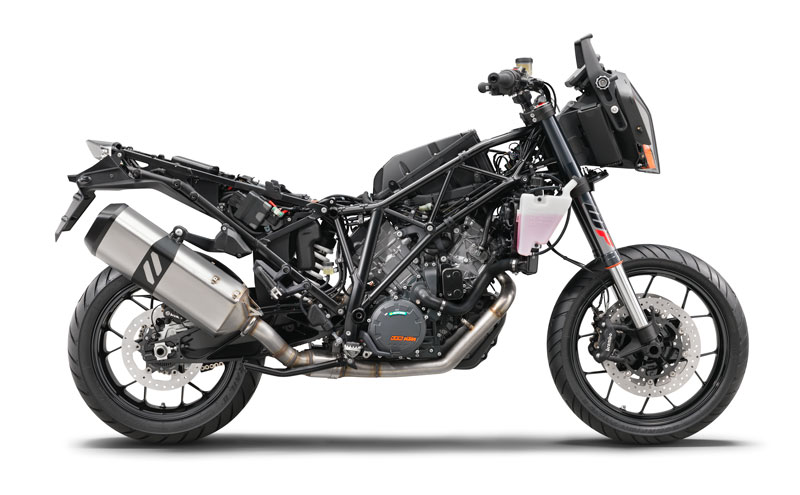
And just as the 950/990 Adventure was the genesis for spin-off models like the Super Duke, Super Enduro and Supermoto, the 1190 Adventure gave life to the 1290 Super Duke R naked sportbike, the 1290 Super Duke GT sport tourer (read our long-term review here) and the latest crop of adventure tourers—the off-road-ready 1090 Adventure R and 1290 Super Adventure R and the new street-focused 1290 Super Adventure S.
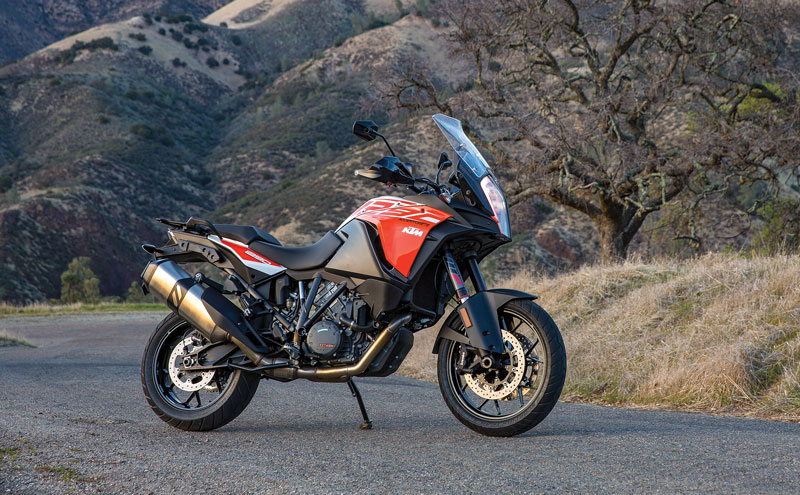
A distinctive design element now shared among several KTM models is a vertically split headlight array outlined by a pair of bright-white LED daytime running lights that resemble downturned horns, like a bull ready to charge. On the 1290 Super Adventure S, the array houses parallel sets of vertically stacked LEDs with low beam, high beam and cornering lights that illuminate sequentially as lean angle increases.
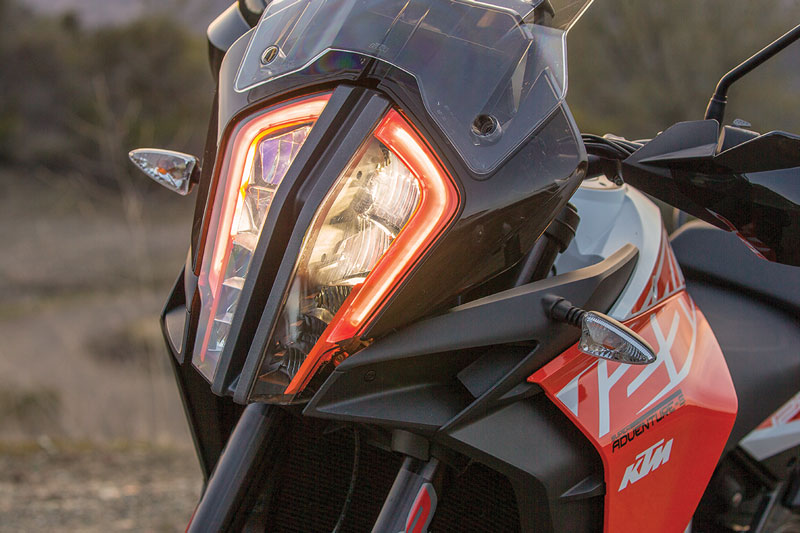
Replacing the analog tachometer and dual monochrome digital displays used for the past several years is a 6.5-inch, full-color TFT display that automatically switches from a white background in bright light to a black background in low light.
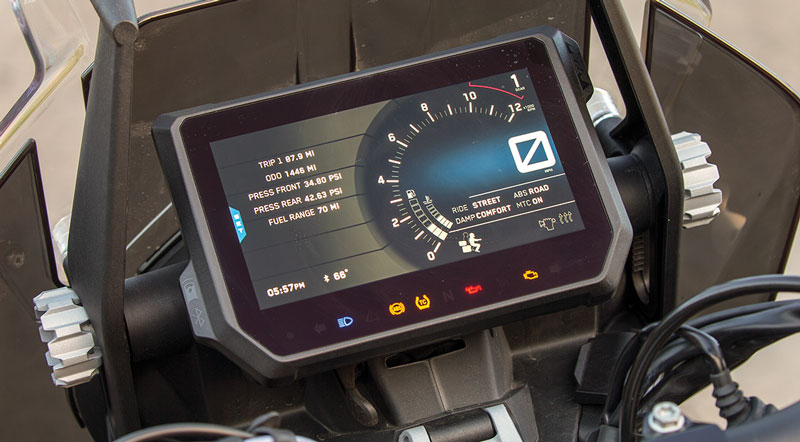
Also new are auto-cancelling turn signals, the Race On remote keyless system for the ignition and fuel cap (inside the fob is a spring-loaded key for removing the seat and locking/removing the accessory panniers), a waterproof smartphone compartment with a USB charging port in the cockpit and the KTM My Ride Bluetooth system. And our test bike is equipped with the optional Travel Pack ($524.99), which adds Hill Hold Control, Motor Slip Regulation and Quickshifter + (up and down clutchless shifting).
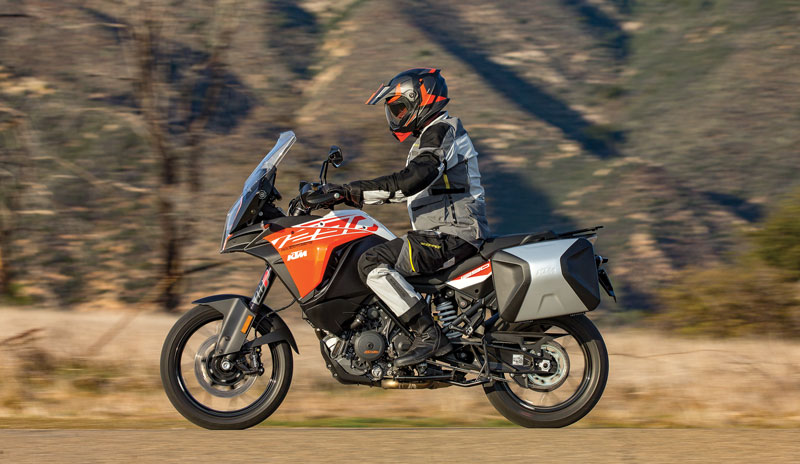
Greg’s Apparel
Helmet: Scorpion EXO-AT950
Jacket & Pants: Scorpion Yukon
Boots: Sidi Gavia Gore-Tex
When the 1290 Super Adventure S arrived, we immediately pressed it into service, using it as our photo mule for a 850-mile comparison test ride to Joshua Tree National Park. In addition to a fast shutter finger, photographer Kevin Wing also has a quick wrist, and he was hard to keep up with on the KTM even though it was laden with fully loaded factory accessory Touring Cases ($1,199.99) and his heavy backpack was stuffed with camera gear.
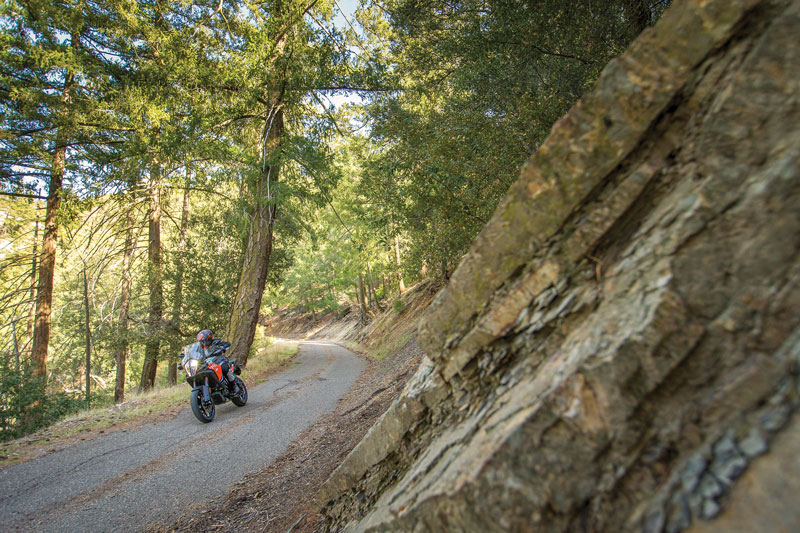
That was a cold, blustery couple of days, and in terms of comfort and wind protection the 1290 passes muster. Its height-adjustable seat (33.9/34.4 inches) is hard and its windscreen, which is manually adjustable on the fly over a 2-inch range, provides only moderate coverage though it deflects airflow smoothly. But wind-blocking hand guards and heated grips keep hands warm, and, as with most adventure bikes, rider ergonomics are spacious and the seating position is upright and comfortable.
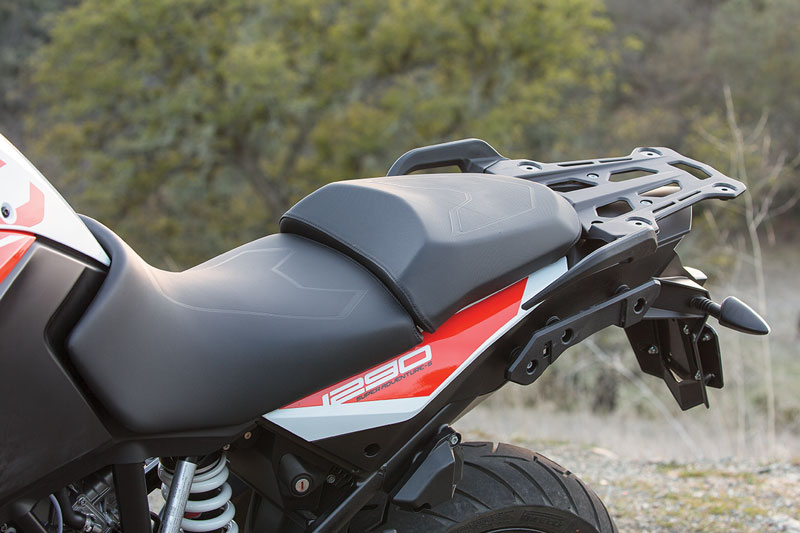
Pack mule, thoroughbred, trail horse, spirited bronco—pick the equine metaphor for the experience you desire and the 1290 Super Adventure S will deliver thanks to its four riding modes (Sport, Street, Offroad and Rain), Motorcycle Stability Control (multi-mode, lean angle-sensitive ABS and traction control) and WP semi-active suspension with four damping settings (Sport, Street, Comfort and Offroad), pushbutton-adjustable rear preload and nearly 8 inches of front/rear travel.
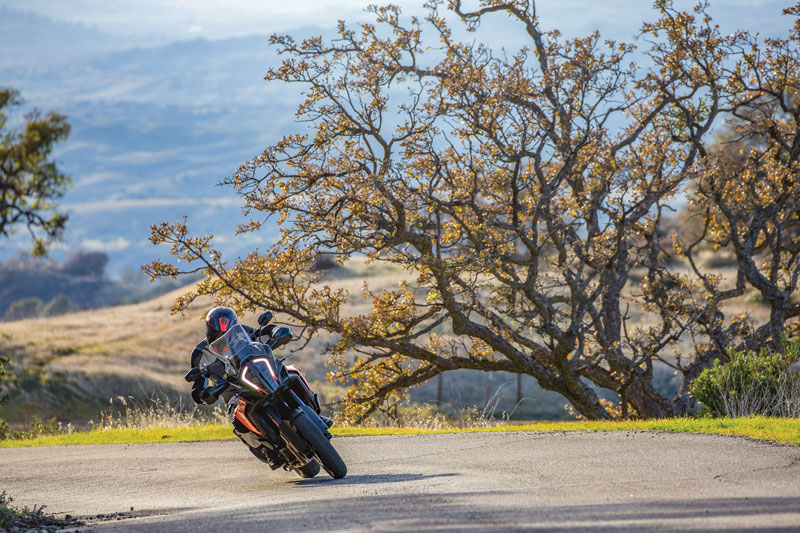
Cast aluminum wheels in 19-inch front and 17-inch rear sizes carry Pirelli Scorpion Trail II 90/10 adventure tires that favor on-road performance but have moderate off-road capability (we stayed on the pavement for this review, but we’ve off-road tested other KTM Adventure models and they’ve been more than up to the task). Add in standard features like cruise control, a tire-pressure monitoring system, a centerstand, a luggage rack and integrated mounts for accessory panniers, as well as a 6.1-gallon tank that’s good for more than 200 miles, and what you get is a well-rounded motorcycle for sport and adventure touring.
That’s what I love about today’s do-it-all adventure bikes: the only thing holding me back is my imagination. Well, that and the usual obligations of employment, family and a mortgage. But seriously, as a Rider staffer I get more opportunities to ride than most, and when it comes to types of bikes and styles of riding, I’m omnivorous and voracious.
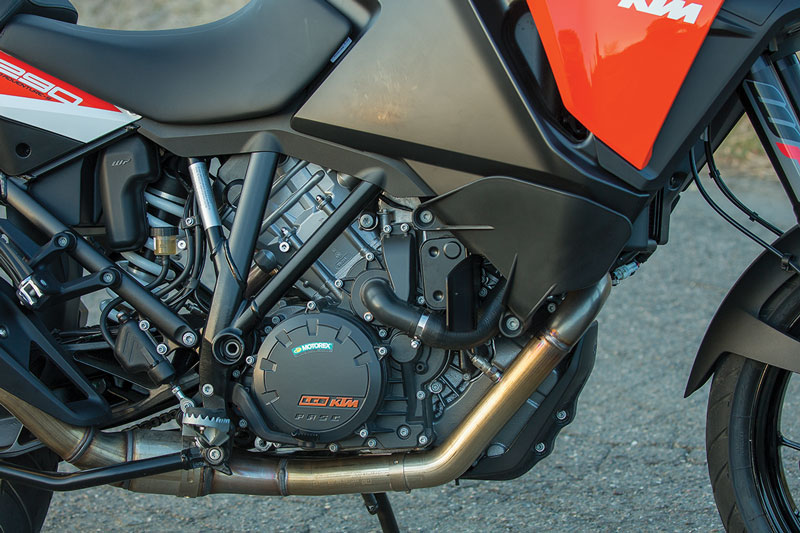
Capable, versatile, exciting bikes like the 1290 Super Adventure S feed all my appetites. For weeks I’ve been commuting on the 1290, and those 50 round-trip miles are a nerve-jangling journey of clogged freeways, lane sharing and traffic lights. With the panniers and luggage rack I can easily transport whatever I need, and with damping set to Comfort the bike floats over U.S. Route 101’s ubiquitous concrete seams. And the KTM My Ride system and smartphone app, with my Sena headset and iPhone paired to the bike, allows me to display and control incoming calls (I decline those while riding), music and turn-by-turn navigation.
On a rare rainy day, I switched over to the Rain riding mode, reducing power, softening throttle response and increasing traction control sensitivity to better deal with the slick conditions. And on a recent morning’s commute, a big, red banner saying “rear tire pressure low” flashed on the TFT display to get my attention. I monitored the front and rear tire pressure readings on the dash to determine whether to pull over immediately or keep going, and with tire pressure holding steady, I was able to make it to work to do the necessary repair, appreciative that the bike was looking out for me.
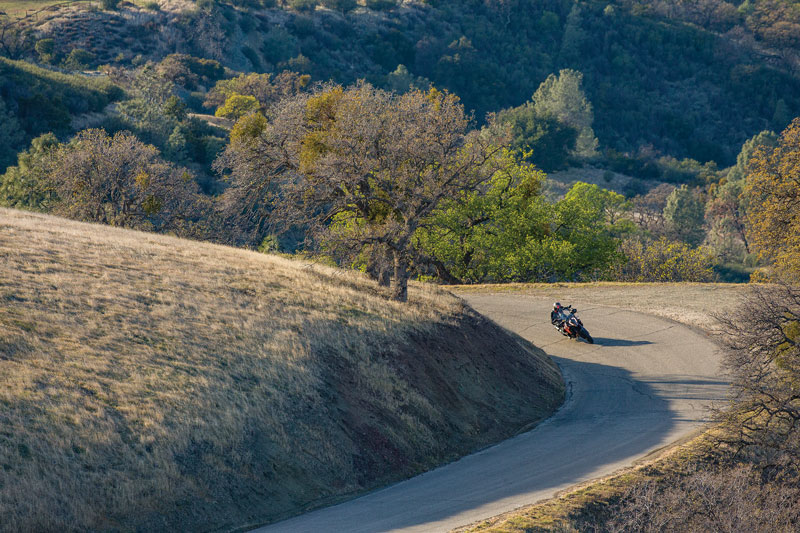
Turn down a desolate winding road, switch over to Sport mode and hold onto the reins—as soon as you give it the spurs, the 1290 launches eagerly into a full-on gallop, lightening the front wheel and mashing the rear contact patch into the pavement. This is riding at its thrilling, adrenaline-fueled best, with a lively, powerful V-twin wrapped in a high-caliber chassis with cutting-edge electronics.
In Sport mode, this version of the 1,301cc LC8 makes 132 horsepower at 9,300 rpm and 81 lb-ft of torque at 7,400 rpm at the chain-driven rear wheel, in a bike that weighs 535 pounds soaking wet. Street mode softens throttle response a bit and ratchets up traction control sensitivity, but it still delivers full power. Rain and Offroad mode, on the other hand, dial down engine output to 86 horsepower and 63 lb-ft of torque, taming the 1290’s red-blooded temper for tricky conditions.
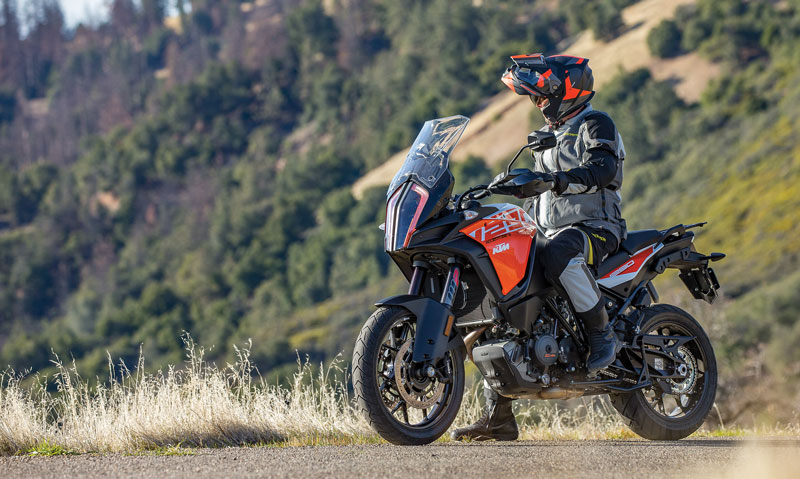
Regardless of the condition of the pavement or the radius of the curve, the KTM is unflappable. There’s no hesitation in the electronic throttle’s response, there’s never any doubt that the semi-active suspension will keep the chassis calm and the tires in contact with the road and there’s nothing but confidence coming from the strong, communicative Brembo brakes.
And I never gave a second thought to shifting the slipper clutch-equipped 6-speed transmission, especially when clicking through multiple clutchless upshifts while hard on the gas (for downshifts I prefer using the clutch for a bit more finesse). The 1290 Super Adventure S feels solid and well integrated, with no glaring deficiencies or compromises.
My two complaints about the 1290 are the same ones we’ve had about KTM Adventures in the past, and they perhaps stem from its performance-oriented nature: the seat is too hard and the engine radiates too much heat. Installing KTM’s accessory Ergo seat may solve the seat issue, but it costs $199.99 and increases seat height by 0.8 inch (a heated version is also available). Engine heat, on the other hand, is less amenable to a quick fix.
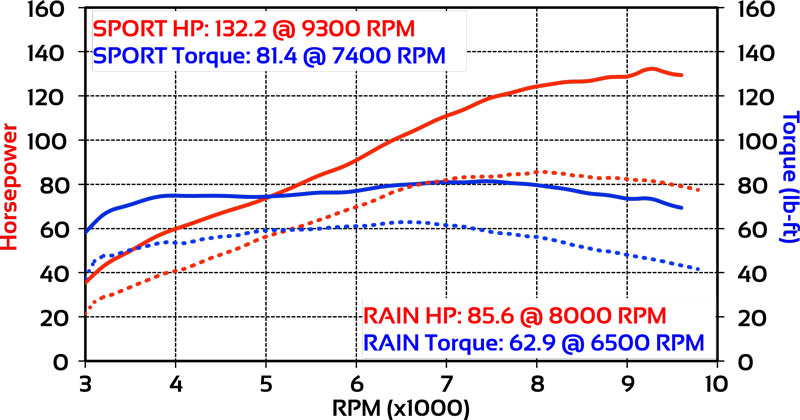
After nearly 2,000 miles of testing, we’re not ready to give the 1290 back and I’m looking forward to our next multi-day adventure. While writing this, I wandered down memory lane and recalled past trips I’ve taken on its predecessor, the 1190 Adventure—a challenging press launch ride around Mount Teide, a volcano in the middle of the island of Tenerife; a multi-day comparison ride and staff campout in Central California, with a few dirt roads thrown in; and an 11-hour superslab ride out to Moab, Utah, for a couple days of trail riding, followed by a scenic return trip through Bryce and Zion National Parks.
Exactly the sort of adventure touring the 1190 was designed for, a mix of conditions and surfaces and speeds. And the 1290 Super Adventure S is more powerful, more sophisticated and better equipped in every way to handle whatever adventure you have in mind. Just remember to drop your mortgage payment in the mailbox on your way out of town.
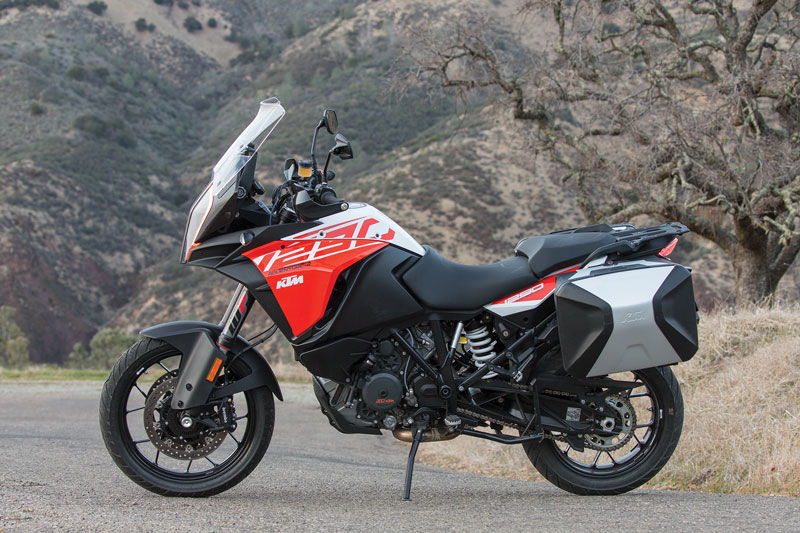
2018 KTM 1290 Super Adventure S Specs
Base Price: $17,999
Price as Tested: $18,524 (Travel Pack)
Warranty: 2 yrs., 24,000 miles
Website: ktm.com
Engine
Type: Liquid-cooled, transverse 75-degree V-twin
Displacement:1,301cc
Bore x Stroke: 108.0 x 71.0mm
Compression Ratio: 13.1:1
Valve Train: DOHC, 4 valves per cyl.
Valve Insp. Interval: 18,600 miles
Fuel Delivery: Keihin EFI w/ 52mm throttle bodies x 2
Lubrication System: Dry sump, 3.8-qt. cap.
Transmission: 6-speed, hydraulically actuated wet slipper clutch
Final Drive: X-ring chain
Electrical
Ignition: Digital electronic
Charging Output: 450 watts max.
Battery: 12V 11.2AH
Chassis
Frame: Chrome-moly steel trellis w/ engine as stressed member & aluminum subframe; cast aluminum swingarm
Wheelbase: 61.4 in.
Rake/Trail: 26 degrees/4.7 in.
Seat Height: 33.9/34.4 in.
Suspension, Front: 48mm USD fork, semi-active w/ 7.9-in. travel
Rear: Single shock, semi-active w/ 7.9-in. travel
Brakes, Front: Dual 320mm floating discs w/ opposed 4-piston radial calipers & ABS (linked to rear)
Rear: Single 267mm floating disc w/ 2-piston caliper & ABS
Wheels, Front: Cast, 3.50 x 19 in.
Rear:Cast, 5.00 x 17 in.
Tires, Front: 120/70-ZR19
Rear:170/60-ZR17
Wet Weight: 535 lbs. (as tested)
Load Capacity:479 lbs. (as tested)
GVWR: 1,014 lbs.
Performance
Fuel Capacity: 6.1 gals., last 0.9 gal. warning light on
MPG: 91 PON min. (low/avg/high) 35.3/38.7/48.6
Estimated Range: 235 miles
Indicated RPM at 60 MPH: 3,500








The heat is a real propblem and that’s a shame for such an otherwise great bike.
On my 1290S I’ve put a ceramic coating on the pipes, lagged the rear pipe and fitted the optional side panels which fill in a small amount of the frame’s trellis work.
It has given a definite improvement, but it’s still pretty toasty. Ironically I think the bike can dissipate the heat as needed when in slow moving traffic, it’s when the bike is on the move and you’re giving it a bit of the “rice & beans” that I find it’s ŵorst. I think the bike just throws off epic amounts of heat.
On a cold day I pulled off a glove while riding and used it as a temperature probe to find the sources of the heat. You’ve got heat coming from the radiator and lowing Dow the side o the bike, coming up from underneath and coming directly up from the under the seat. I honestly think the issue is that they all add together and the natural vortex behind a riders knees pulls all the heat behind the knee/thigh.
What it needs is a way of fresh air to be vented along/under the tank and coming out under the seat/behind the knees. This would increase air flow and air pressure at that point which should stop the heat being drawn inwards in the first place.
Anyway It is a fantastic bike to ride which makes it at least a balanced argument about the heat!
Thanks for the comment! I was wondering about the heat because I test rode the original 1290 SA and that sucker released some serious heat on a hot/humid summer day here in KY. I was hoping it was reduced with this new 1290 SA-S. I typically don’t complain about engine heat much but man that thing was roasting me, even in mesh gear.
You didn’t add all the accessories into the price bags $1199.00 heated grips $159.00.
I’m about to retire my 2013 1190 Adv (not the R) in favour of this, its more refined and sprightlier descendant, though mine will be the one dressed in black.
The 1190 has served me well, and is the best bike I’ve ridden of more than a dozen over a span of some 30+ years: nimble, sure-footed, well-behaved (mostly), and a delight to ride. Equally impressive is how the KTM dealer attended to the OEM recall/upgrades (air box, heat shield) with impressive alacrity. Brand loyalty is definitely warranted here.
I’ve now had my anthracite-grey SA 1290 S for a month. Wow, what a bike! The most immediately obvious differences from the 1190, apart from the cosmetics (headlight, TFT display, wind screen controls, etc.) are threefold:
1. Noticeably more low-end torque;
2. Much firmer seat (bordering on hard); and
3. The soundtrack’s more throaty and uneven (perhaps due to running-in mode).
A biker friend who’s owned a SA 1290 R for several months told me that his bike accelerates marginally faster up to about 160 km/h (100 mph) than the Superduke R, though the latter has the upper hand on top end. Apparently he established this by direct competition with a Superduke R owner. (We’re at an altitude of about 5,500 ft.) I’m not really too surprised by that result, now that I’ve felt the SA’s amazing torque delivery.
Great commentary and review
I’ve owned a 1290 SA S for 2 months now, covering about 2,500 miles. I am seriously impressed with it so far. It does chuck out a lot of heat but I’ve only really found that an issue on very warm days. The seat is pretty hard but it seems to be softening up a little now – or perhaps I am starting to get used to it. I have come to the 1290 from a long list of sports bikes so I am finding the comfort and tank range to be real luxuries. However I’m not compromising much in terms of performance and handling. What a great bike.
Here in the Southwest where we have 60+ days over 100° I’m leery of a bike that gives off that much heat. Too bad as it otherwise seems to have it all. Does it still give off that much heat when it’s in “Rain” mode producing less horsepower?
I’m prity sure if you de cated it,it would solve a lot of the heat issue… Never heard anyone mention this as a cure,but that’s what I think.
The heat isn’t as big a deal as they are making it out to be, and is certainly no reason not to get one. I have the R and am not bothered at all about the heat. There is literally nothing wrong with these big KTMs — they are remarkable machines.
I have a 2020 and don’t find the heat to be an issue.
Hi to all new owners of the KTM 1290s, please advise if any of your the bikes suffer from annoying vibrations, my 1190 standard has a bad vibration through the bars between 100-120 km/h,we have tried all the remedies posted bu to no avail
cheers
Morgan
Morgon, I’ve been driving my 1290s 2018 for one season. My first adventure bike. Test drove it for a day and went back to the dealer and signed the papers before i left. Instant love. The engine and handling of this bike is… pure happiness 🙂
About vibrations. No.. It’s really smooth. Even at high speeds it feels very steady. Sure, it’s a big v-twin so there’s vibrations from that – but in a good way 🙂
Hi guys. I’m considering trading my Triumph 1200 Explorer for a (new) 2018 KTM1290S but am worried about the comments regarding engine heat. Here in Australia, I do a lot of km’s in temperatures up to & over 30degC & engine heat is a worry. My previous bike, a 1200GS has no such issues for obvious reasons & I find the Triumph to be okay. Also considering trading my Triumph on a new Triumph 1200 Tiger.
I got rid of my 2015 Multistrada because: the handling was bad, it wanted to do tank slappies all the time; the throttle maps made it dangerous round town, any old lady in a Prius can out drag you; most of the parts are made out of cocoa tin, so constant repairs and servicing are ridiculously expensive. A 1290S would have been a great replacement, but the heat would be a real issue for me, so it looks as though I’m back to a Tracer 900GT
Really? Tracer isn’t in the same ballpark I reckon, but is quite a bit cheaper in fairness.
BMW S1000XR doesn’t appeal to you? I’m always surprised these bikes (SA vs XR) aren’t compared more often, as they’re the two in this sector that have the most comparable price/build quality/performance.
2019 model must have solved the heat problem. I have never noticed it to be any worse than anything else I have ridden with an engine of this size and power. Ducati of any bike with a twin this size is way worse. I have had several.
Strange things that took me a while wondering about and trying to understand this bike:
– The Adv bike with the largest engine displacement in the market is lighter than 90% of 1000cc naked bikes!
– 1300cc Vtwin with that high compression, hp and torque .., and not vibrating like a big bore V twin.
– Chain drive on a big adv
– It’s an Adv but not blended form offroad / touring like most in the market, it’s more of a Hyper Naked / off-road / “some” touring blend
Riding experience:
– Power and maneuvers is the first comment form everyone who tested it so far, Powerful response and sharp maneuvers that feels like a good 1000cc street bikes
– Popping off the font wheel and pushing the traction control beyond its limits and having the rear wheel spin is very normal, you have to take it very easy on throttle, btw this happens also at higher gears and speeds
– At low speeds power delivery is very smooth and not cranky at all (expect on sport mode needs you to be a bit sensitive on throttle)
– Idle RPM is high ~1500 needs some time to a adapt then its a not issue
– Always asking for a lower gear, you can’t pass a speed bump at none adv speed bump speed 🙂 on 2nd gear you must shift down to 1st,
– 5th and 6th are not the gears to cruise less than or equals 100Kph, 4th is the 100kph cruising gear in this KTM
– Braking performance, KTM was pragmatic enough to handed over the braking system to Brembo
– Neutral is not easy to catch. You have to be sensitive or have good gear box mechanical experience 🙂
– Vibration is very minimum till 6 rpm then you start to feel it a bit, but it depends on your perspective, compared with Japanese cruisers, Ducati, off-road bikes it has no vibration, compared to Japanese 4 inline or parallel twin it has a bit vibration feeling
– Suspensions for a person like me, semi adaptive electronic suspension feels like a spaceship, – Damp settings Sport, Street, comfort, Off-road do exactly like it’s name
– Setting Damp, preload, abs, riding mode on the fly is real +
– Fuel weight well distributed and at low hight
– When you want to get the hell out of the 160hp it burns fuel like street bikes, other than that consumption is good for travel and commuting
– Heat: it’s like eu cars it heats till 90-100 degrees and keeps like that all the time, 100% not as hot as described on forums especially if you are used to hot weather or 1000+ street bikes.
while commuting in sunlight 38 degrees, you feel “some heat” from the seat but I would say a very normal heat, no concentrated heat at you legs and feet at all, so it’s a normal big bore heat however in concourse I’ve experienced all lot more and was having a much bigger complain
– Wheelbase is a bit short compared to ADV bikes, its makes it jump higher and easier maneuvers also easy to spin the rear wheel this must be taken in account while cornering
– Highway riding: street bike acceleration and braking performance all the way,
– Handling response gets harder after 200kph, not convenient after 220, more of a boat traction (probably because height and weight) also it’s not the use case for an adv bike
– Accelerates faster than the suspension semi adaptive, if you reach 200+ very quickly you’ll need to wait couple of seconds till the suspension adapts
– also the front wheel always lifts up when accelerating on any speed so you lose a bit of a traction in the front wheel during sudden acceleration, if you’re well connected with the bike and have the right experience it’s just a muscle memory
– don’t think 250+ Kph is an option as advertised unless you are in a straight tunnel alone:) over 200 the risk strats and over 220 it’s totally out of its comfort zone, not sure but I think it’s locked at 23x kph.
it maneuvers and corners very sharp but your head is very high, you need to change your body position if you’re going extreme.
TFT is very nice but as usual KTM fonts are too small,
Mobile connectivity is good for caller id and media playing also controlled form the handle bar is nice, puting google maps on the TFT was supposed to be there, ktm navigation app is useless. so the company that handed over the braking to brembo are trying to compete with Google in SW 😀
Handlebar switches, finally! they light at night 🙂 Also you control everything with 4 bottoms very easily and conveniently once you get used to it.
Although the user manual rejects to adjust the windscreen on while riding, it’s really very easy to do, but don’t tell anyone
other than the Adv and travel capabilities, it’s a good bike to commute in case your commute mixes city with highway, also for egyptial silky smooth roads
Top case and a tank bag should be the maximum luggage settings (a duffle on the pylon for long trips) side cases will kill it, you will lose the benefit of having a very fit / slim bike, also weight on the front wheel is already low, side cases + rack will make it lose more traction easily.
Negative things that must change / upgrade (at least for me):
– Seat is very hard after 45mins, but KTM ergo seat solved the issue for 200$
– Bar height needs to raise to the maximum of the cables (SW motech solved it)
– Windscreen is a failure from KTM 🙂 no protection and zero optical correction in case somebody is short enough to see through
-Foot pegs at the lowest settings are still high for a 185cm+ person (solved by the 20mm height I got form the ergo seat), however compared to something like super tenere there are still room for dropping it lower.
A very good adv for road / trails, R version will nail it in extreme off road
Feels well built, and holding itself together
Don’t get it if:
– You have overweight to obese body
– if you are planning to have 3 hardcases and a passenger all time
– if you are shorter than 170 cm (unless you’re an expert rider)
– if you didn’t ride a fast bike before (sports, sport touring, hyper naked…) you need to be used to such a response before combining it with Height.
– if you have soft hands 😛 and consider the chain maintenance a pain in the ass.
– if the 160hp is your only attraction go get a street bike, it’s a powerful adv with a powerful street capabilities, so you have to see it a and ADV not street
Other experience
– Stock exhaust is already loud and sounds good, improvement should be for different tone or lighter weight but not a louder volume
– Tool box and user manual are targeting riders who work with their own hands
– Oil change parts are more expensive around 50$
– needs a very special oil 10w-50 but not necessary Motorex
– aftermarket parts are much cheaper than japanese bikes
– very easy to move around in parking (like a naked bike)